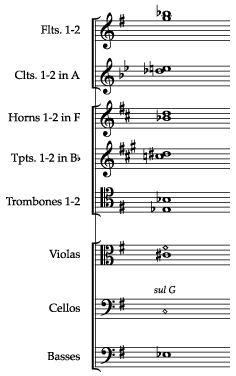Composition majors take a different orchestration exam.
Please contact the Composition Department for details. This examination tests general knowledge of orchestral instruments and skills in the areas of score comprehension and literacy, and orchestration. The actual exam must be completed within 60 minutes and will be graded with PASS or FAIL.
General study suggestions
- Adler, Samuel. The Study of Orchestration. 3rd edition. W. W. Norton & Co., 2002
- Kennan, Kent and Donald Grantham. The Technique of Orchestration. 6th edition. Prentice Hall, 2002.
Strings
1. Name the open strings on:
2. What does sul D mean?
3. What is the II string on the cello?
4. Name two general categories of playing a string instrument (i.e. with and without the bow).
5. What is the German name for the Violin?
6. What are the five string sections found in the typical symphony orchestra?
Woodwinds
1. Name the four woodwind families found in the typical symphony orchestra and indicate whether each family consists of single-reed, double-reed, or non-reed instruments.
2. Match the woodwind instrument with its English name.
3. Indicate whether each instrument is more comfortable playing softer or louder on lower notes.
Brass
1. What does depressing the first valve do on a trumpet?
2. How many slide positions are there on the tenor trombone?
3. What is the standard orchestral brass mute?
4. Match the following brass terms.
For the remaining questions, you will need to download and print this pdf file.
Written Ranges
For the instruments listed below, indicate which clef or clefs are used and give its lowest possible written note, excluding changes of tuning or use of pedal tones.
- Bb Clarinet
- C Trumpet
- Tenor Trombone
- English Horn
- Cello
Concert Pitches
For the written notes given for instruments below, write the proper concert pitches (i.e. correct sounding pitches). Include the appropriate clef, and include accidentals if needed.

Orchestration
Orchestrate the excerpt below for the forces provided. It is not necessary to use all of the instruments, but use more than simply the strings.
